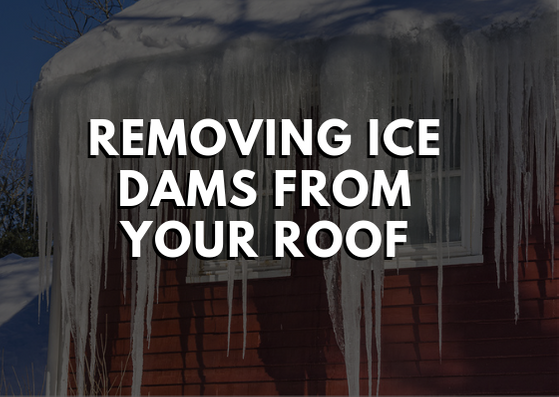
Icicles hanging from the eaves of your roof during winter may be a quaint and pretty sight, but they can also be a sign of a major hazard: ice dams.
An ice dam is as an accumulation of ice in thick ridges on the eaves of your roof that can block gutters and prevent water from properly draining off. This wintertime nuisance can result in torn-off gutters or damaged shingles, and can cause water to back up and leak into your house, possibly resulting in damaged, stained ceilings and ruined paint. Worse, a leak can cause wet insulation that attracts mold and mildew.
Ice dams form as a result of warm air inside your home rising and heating the roof. As the heated air rises, melted snow run-off drains down the slope of the roof to the eaves where, due to cooler temperatures at this part of the roof, the liquid re-freezes.
Ice accumulates, causing water to back up onto your roof, which typically then goes through multiple freeze-thaw cycles. The process causes water to seep under shingles, and eventually into your home through leaks in the roof that can be exacerbated by water freezing and expanding in them.
Ice-Dam Prevention
In order to avoid the costly repairs associated with ice dams, they need to be addressed as soon as possible. Preventing them, however, is the most effective way to deal with them. This can involve more short-term solutions, like using heated cables along the edges of your roof to prevent ice from accumulating, or more involved long-term solutions.
Long-term solutions for ice-dam prevention involve addressing the structural integrity of your home and roof. This could include addressing potential leaks, improving attic ventilation and floor insulation, updating older heat-creating recessed lighting with insulated can lights, and replacing flashing around areas such as chimneys.
Cleaning your gutters in the late fall and removing debris is also a strategy for preventing ice- dam build-up.
Ice-Dam Removal
While prevention is the number one strategy for managing ice dams, they may have already formed on your roof and will require removal. Here are some strategies for taking care of this challenging winter problem:
Using tools. Using a tool like an axe or pick to break up and remove an ice dam is the least recommended strategy for removal. Climbing onto a snowy, icy roof is dangerous in and of itself, and using a sharp or pointed object to break up ice simply compounds this danger. Of course, trying to manage ice dams in this way can result in damage to a roof because shingles and roofing materials are typically weaker and more easily damaged in cold temperatures.
High-powered steam. There are professionals who specialize in ice-dam removal using high- powered steam, a safe and easy solution.
Using de-icers in conjunction with a snow rake. This is the safest and most recommended strategy for removing ice dams yourself. Remove snow from the edge of your roof using a roof rake. Use a calcium chloride de-icing product either in the form of tablets or in granulated form inside nylon stockings. The filled stockings can then be placed across the ice dam and will melt channels through the ice.
Don’t use rock salt for this strategy as it can cause significant damage to your roof. Similarly, be sure to cover any landscaping below your eaves when using this method to prevent the chemical-containing run-off from damaging shrubs and plants.
Using hot water. This is not a recommended method as the water used to melt ice dams can quickly cool, freeze, and compound the issue you’re trying to address. However, it can be used in conjunction with the above strategy to make some headway on the ice dam removal process.
Unless your home has been specifically updated to prevent ice-dam formation, removal may be an inevitable aspect of managing the effects of winter on your home and roof. Being preventive versus intervention when it comes to dealing with ice dams is really the most desirable strategy for maintaining your home’s integrity this winter.
If removal is a must, consider the safest method for both your home and yourself and be sure to address this winter challenge as soon as it’s detected to avoid any serious damage that might result.


